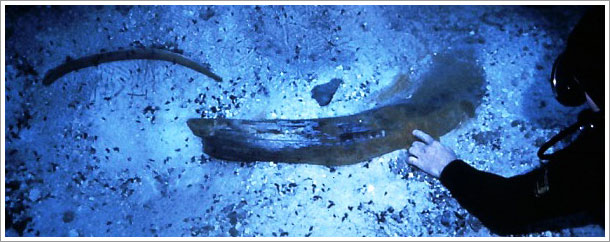Drowned Prehistoric Sites

When the sea level rose at the end of the last Ice Age, Florida's coastal plains became submerged continental shelves. The inland water table also rose, and prehistoric sites of human activities were slowly inundated (flooded). These formerly dry sites represent places where Native Americans lived or camped, manufactured bone or stone tools, killed and butchered game, gathered and ate shellfish, or buried their dead. They occur in a number of settings: in the sea along the east and west coasts of Florida, and inland along ancient river banks, lake shores, and in sinkholes.
Many prehistoric sites under water have remained relatively undisturbed over the centuries, while others have become eroded and scattered by tide and river action. A good example of a well-preserved prehistoric site is Little Salt Spring, a natural limestone well in Sarasota County. Little Salt Spring has produced evidence of a Paleo-Indian site from 12,000 years B.P. (before present), and an Archaic period village with a cemetery of around 8,000 years old! Another site where important prehistoric archaeological remains have been preserved and excavated is nearby Warm Mineral Springs.
A number of Florida's river systems contain evidence of extinct mammals associated with prehistoric Native American artifacts. Sport divers have reported and recorded a number of sites in the Aucilla, Wakulla, St. Marks, and Chipola Rivers. In central Florida, the Suwannee, Santa Fe, and Ichetucknee Rivers have been explored by divers who have found a vast network of springs and caves that contain evidence of the first Americans. Recent investigations by sport divers working with state and university scientists in the Aucilla, Ichetucknee, Oklawaha, and Wacissa Rivers have revealed a variety of drowned prehistoric remains both in and on the sides of river channels that promise to be of great significance. This research is continuing offshore in the Gulf of Mexico, where ancient river basins are now under water.
The remarkable preservation of organic materials found on submerged prehistoric sites in Florida can give us clues about past environments and the people and animals that coexisted in them. Studies of climate change, food preparation, tool manufacture, burial customs, skeletal structure, genetic adaptation, and other avenues of research, are now beginning to benefit from the discovery and careful investigation of Florida's "wet sites."

